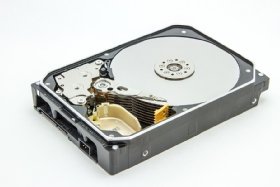
Anna Khomulo - Fotolia
Modern HDD technologies that are bringing hard disks back
Don't write off HDDs just yet. Energy-assisted technologies such as MAMR and HAMR may keep hard disk drives competitive in an evolving secondary storage market.
Hard disk drives may be considered obsolete by some, but modern HDD technologies have made significant strides in increasing storage capacity and speed. SSDs, cloud-based storage and software-defined storage may have made headlines in recent years, but HDDs are set for a comeback.
Thanks to some new -- and not so new -- developments, HDD technologies are becoming more competitive in the secondary storage market. Energy-assisted technologies, also referred to as energy-assisted magnetic recording (EAMR), enable vendors to increase HDD density and capacity without putting additional disks inside the hard drive.
Microwave-assisted magnetic recording (MAMR) and heat-assisted magnetic recording (HAMR) are getting a lot of attention in the storage market, but they're just two of the technologies you should be familiar with. EAMR technologies such as shingled and perpendicular magnetic recording (PMR) have paved the way for increased HDD capacity.
Perpendicular magnetic recording
PMR is also known as conventional magnetic recording. It was first studied in 1976, but it didn't become commercially available until 2005. It's responsible for major developments in tape capacity, and it's one of the HDD technologies that paved the way for EAMR disk drives.
Traditional HDD technology aligned bits horizontally relative to the disk platter, whereas PMR aligned them vertically. This development increased the areal density -- gigabits of data per square inch -- of disk storage without adding more disks inside the drive.
Shingled magnetic recording
In shingled magnetic recording (SMR), tracks of data partially overlap like shingles on a roof. This design enables more data to be written on each disk. Prior to SMR technology, tracks of data on HDDs ran as close together as possible without touching, which made it difficult to increase drive capacity. SMR beats that limitation by writing data sequentially and overlapping the tracks, which increases density.
SMR performance can be inconsistent with random writes and modifying prewritten data, so it is better suited for long, sequential writes. This makes SMR a good fit for backup and archiving.
Heat-assisted magnetic recording
HAMR hard drives increase the capacity of HDDs through heating the storage medium on the disk during the write process. Heating the disk makes it more receptive to magnetic recording and able to store more data in smaller areas of the disk.
Seagate Technology has promised 20 TB HAMR HDDs by the end of 2020, but progress with HAMR technology has been slow. Seagate has been looking into HAMR drives since 2002. HAMR involves a complex manufacturing process. Along with the costs of implementing the injection lasers that heat the disk, heating up and rapidly cooling the disks is a delicate operation.

Microwave-assisted magnetic recording
MAMR is causing a stir in modern data storage. Major HDD vendors Seagate, Toshiba and Western Digital have all been exploring the MAMR technology along with HAMR. MAMR is regarded by vendors as more reliable than HAMR because it does not require the same heating process and use of lasers. MAMR drives function similarly to PMR technology and require disks similar to those in PMR drives. If a vendor is producing PMR drives, it would need to make minimal manufacturing changes to pivot to MAMR.
MAMR drives require a spin-torque oscillator, which creates an electromagnetic field near the write pole. This approach enables writes at a lower magnetic field and greater drive density. As with HAMR, HDD vendors haven't deployed full MAMR HDD technologies. Western Digital has released EAMR drives that incorporate aspects of MAMR.





